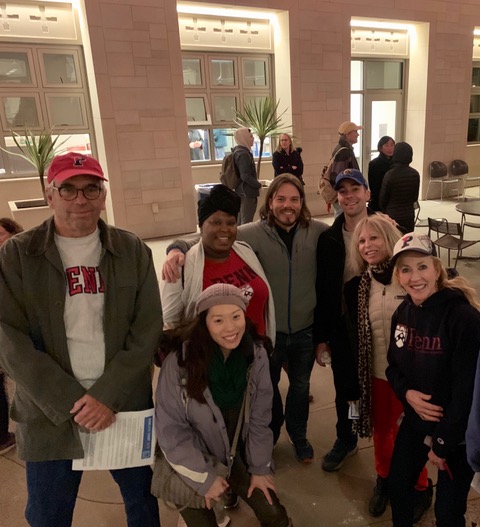By Jane Gutman, CW’73, PAR’14, PAR’16

Penn Serves LA Volunteers gather in Santa Monica at midnight in January 2019 to help count the homeless.
“California has a quarter of the nation’s homeless.” This was one of the many stunning facts about homelessness that twenty plus Penn volunteers learned during a chilly evening in January when we gathered at 10:30 pm at a church in Santa Monica before heading out to “count” the homeless.
Our Penn Serves LA group was part of a phalanx of thousands of volunteers who were deployed across Los Angeles over three evenings in late January to count the homeless, which would then determine how resources will be distributed and to measure how local and state governments are doing in their efforts to manage this exploding challenge. Between 2016-17, homelessness surged by 26% in Los Angeles County to a devastating 55,000 people. In 2018 there were 957 unsheltered people in Santa Monica, up 4% from the prior year.

Penn Serves LA Volunteers waiting for instructions to help count the homeless in Santa Monica
In 2017 LA County voted in a quarter-cent tax through Measure H, which will raise $355 million a year over a decade to help with outreach, shelters, and housing. The “crisis on the streets” is immensely complicated: mental, health issues, high rents, lagging wages, etc., etc. As Martin Luther King said, “There is nothing new about poverty. What is new, however, is that we have the resources to get rid of it.”
For the Santa Monica Homeless Count, we were divided into sixty-odd teams of four people, and each team was given a precise map of an area where we were to walk and make note of people sleeping on the streets or in cars. Prior to heading out, at a time chosen because homeless people are usually settled by midnight and thus we could get the most accurate count, we received training about how to identify homeless individuals and encampments.
Over fifty people representing the police, mental health professionals and elected officials were there to support the volunteers. Terry O’Day, the Mayor of Santa Monica, explained how Santa Monica cares for its homeless with a continuum of services aimed at addressing the problem and preventing its expansion. Each speaker was moving and inspiring, and all shared in expressing that it will only be through collective efforts that homelessness can be eradicated.
The rallying cry was, “Volunteer, Donate and Advocate” to solve the problem. Imagine if each of us either gave an hour a week of our time, gave $5 a week of our money or wrote a letter every week to a politician what might be accomplished.
And with that, we hit the streets with our teammates. It was very cold and very dark, but of course, we were only out on the streets for an hour or two…imagine!
You can read the results of the 2019 Santa Monica Homeless Count here and see a video about this year’s count here (we saw a few of our Penn Serves volunteers have cameos in the video).
Upcoming Events
- April 27 – Discover Your Inner Artist: Arts Day with Valiente Prep Charter School
- June 22 – Sound the Alarm, Save a Life
About Penn Serves LA

Penn Serves LA impacts the Los Angeles community by engaging University of Pennsylvania alumni, parents and families in meaningful community service activities.
Since our founding in 2012, we have done everything from serving meals to the homeless to restoring the environment to fixing homes. Six times annually, we find another great opportunity to learn about interesting nonprofits, lend a hand and enjoy a fun experience with fellow alumni.
Join Us
We invite the Penn community in Los Angeles (alumni, parents, and kids) to join us at a future event, to help spread the word and to help us plan future activities. Join us, meet new Penn people, demonstrate what service means to your kids and friends, and help fellow Quakers make a little bit of difference in our complex city!
If you have an established nonprofit that you would like us to consider for future events or announcements, please let us know. We are looking for new nonprofits to serve in meaningful ways.
Contact Us
Questions? Want to join our email list? Reach us at pennserves@gmail.com.
Like us on Facebook and follow us on Instagram and Twitter!
The Penn Serves LA Team
Michal Clements, W’84 | Justin Gordon, W’05 | Jane Gutman, CW’73, PAR’14, PAR’16 | Leanne Huebner, W’90 | Jamie Kendall, W’04 | Irene Park, C’05 | Kiera Reilly, C’93 | Michelle Wattana, C’09 | Denise Winner, W’83, PAR’21
Read about our previous events:
- March 2019 – Be a Doll, Make a Difference (coming soon)
- October 2018 – A Place Called Home – A Day in the Garden (coming soon)
- September 2018 – Pasadena Educational Foundation (coming soon)
- August 2018 – Hug a Cow, Rub a Pig’s Tummy and Paint a Barn at Gentle Barn (coming soon)
- April 2018 – Beautifying the Roof for the Skid Row Housing Trust
- March 2018 – Making Mosaics with Piece by Piece
- February 2018 – HomeBoy Industries, HomeGirl Cafe, and the Guadalupe Homeless Shelter
- January 2018 – New Year Social
- 2016 – 2017 – Year in Review
- November 2017 – Thanksgiving Dinner with Fred Jordan Missions
- October 2017 – Penn Serves LA and TreePeople at the Audubon Center
- September 2017 – Penn Serves LA Restores the Ballona Wetlands
- August 2017- LA Works Pop-Up Day of Service
- July 2017 – Portraits of Hope
- May 2017 – Food Forward
- April 2017 – Habitat for Humanity
- January 2017 – Penn Serves LA Toasts the New Year
- January 2017 – Blankets of Love
- November 2016 – A. Kitchen
- October 2016 – Got Books? Penn Serves LA Staff’s ICEF First Literacy Festival
- March 2016 – Rescue Rabbits
- October 2015 – Penn Serves Picks Packs of Peppers at Westside Food Bank
- September 2015 – Penn Serves LA Reads to Kids
- July 2015 – Penn Serves LA: Harvesting a Garden for Veterans
- June 2015 – Penn Serves LA Spruces up a New Charter School
- June 2015 – Penn Serves LA Has the Giving Spirit
- August 2014 – Penn Serves LA Strikes Again: This Time with Paint!
- December 2013 – Holidays are a Time for Giving
- November 2013 – Sending Holiday Warmth to our Troops
- August and September 2013 – Serving the Environment and LA Leadership Academy
- May 2013 – One on One Outreach
- March 2013 – Habitat for Humanity
- January 2013 – Inner City Arts
- September 2012 – The Midnight Mission
- June 2012 – Turning Point Shelter







